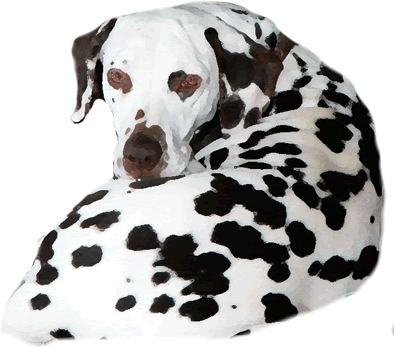
The Dalmatian Backcross Project commenced in 1973 with the original outcross of an AKC registered Champion Pointer sire CH Shandown's Rapid Transit (click here for photo)
bred to an AKC registered Dalmatian dam Lady Godiva (no photo).
Dr. Robert Schaible conducted the breeding in an effort to address the Dalmatian fixed genetic defect that affects uric acid metabolism and that may lead to increased urinary uric acid, urate crystals, urinary bladder aggregate formation, stones, urinary tract obstruction and even death.
AKC registered Dalmatians were used in subsequent matings of the progeny of the original Dalmatian-Pointer cross. The first three matings, termed “backcrosses”, yielded progeny generally distributed as ½ Low Uric Acid (LUA) and ½ High Uric Acid (HUA). LUA and HUA backcrosses were initially distinguished by a ten-fold difference in their urinary uric acid to creatinine ratios in spot urine samples. Today DNA analysis is done to identify the specific single gene that has been discovered and is thought to control normal canine uric acid metabolism, residing on canine chromosome number three.
The breeding program is now termed the “Dalmatian Low Uric Acid Project” and is presently at the 14th generation from the original cross. The progeny have 99.98% AKC registered Dalmatians in their pedigrees and on parentage analysis (click here for more info). Their DNA is 99.8% the same as AKC registered Dalmatians. These facts suggest that the LUA/HUA Descendants cannot be distinguished genetically from AKC registered Dalmatians. For a detailed discussion of this science, click here.
LUA puppies exhibit a 10-fold lower urinary uric acid to creatinine ratio on spot urine testing compared to HUA littermates. This phenotype persists into adulthood as demonstrated by the ten LUA Descendants that have been tested so far that demonstrated a 6-fold lower ratio when compared to high uric acid Dalmatians. Four LUA Descendants have undergone urinary bladder ultrasound performed by Dr. Susanne Hughes and were found to be free of bladder “sludge” or aggregate material.
Notwithstanding these encouraging findings, whether LUA Descendants impact significantly on urinary uric acid related clinical syndromes compared to either their HUA littermates or to AKC registered Dalmatians remains to be proven. Despite the fact that all AKC registered Dalmatians are homozygous recessive for the fixed genetic defect, not all such Dalmatians produce urate crystals, stones or related clinical syndromes. The reasons for this may relate to improvements in animal husbandry (strict diet control and generous water intake), or may imply causative factors other than increased urinary uric acid. In addition, preservation of breed “type” – adjudicated by the approved AKC Dalmatian Standard – remains to be assessed in future generations.
The information on this site was compiled by Irvin B. Krukenkamp, MD, June Krukenkamp, Dennis Trout, & Tracie Tepke, with generous contributions from many LUA Dalmatian breeders/owners including Dr. Schaible, Denise Powell, Karen Rochin, Mary Lynn Jensen, Marion Mitchell, Carol Chase and Sara Ledgerwood. The site is donated to the benefit of developing Normal Urinary Uric Acid in all Dalmatians by Dr. and Mrs. Krukenkamp.
Correlated URLs that point to the same website include www.nuadalmatians.com
<http://www.nuadalmatians.com> and www.backcrossdalmatians.com
Facts & History about the Low Uric Acid Dalmatians
Home | History | Basics | Health | Meet The LUA'S | Pedigrees | Publications | Statistics | FAQS | Breeders | Contact
Home | History | Basics | Health | Meet The LUA'S | Pedigrees | Publications | Statistics | FAQS | Breeders | Contact
